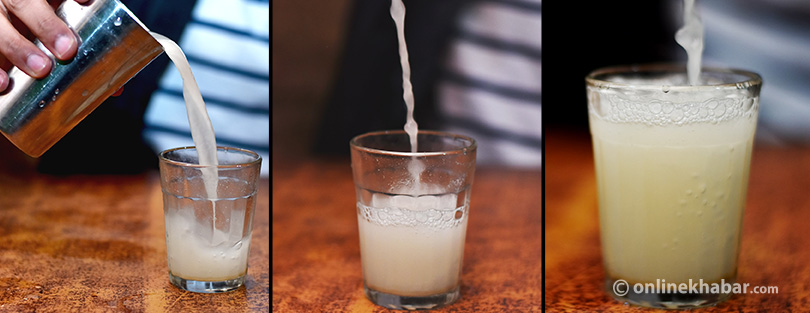
Dashain might be over but the celebrations, in various names, still continue in Nepal, where festivals even outnumber the number of days in a year. Every celebration, in many Nepali homes, is incomplete without the local brews and traditionally cooked meat, recipes for which have been passed down from one generation to another. The most popular among local alcohols in Nepal is chhyaang or thon, sometimes referred to as the ‘Himalayan Beer’ or the ‘Nepali Beer’.
Chhyaang is a fermented rice beverage, similar in appearance, taste and production method to the unfiltered varieties of Japanese sake.
It is believed that a Chinese princess, who tied the knot with a Tibetan king during the seventh century, brought the brew to the kingdom as part of her dowry, and later on it was adopted as a welcome drink of the courts. However, according to another Sherpa belief, Guru Padmasambhava was the first one to drink chhyaang and hence the Tibetans present it as an offering to him.
Legend has it that the Tibetans were building the Samye Monastery, but could not complete it. Guru Padmasambhava came to their rescue sprinkling drops of chhyaang on the incomplete monastery. Only then were they able to complete their work. Thereafter, Tibetans started drinking chhyaang as a gift of God.
Chhyaang is also said to be the best drink to fight cold of the mountains. According to the Sherpas, it has many healing properties for conditions such as common cold, fevers, allergic rhinitis, and even alcoholism! High in the mountains, it is the spirit that keeps them warm.

Among the ethnic beverages of the region, the mild-alcoholic, sweet-flavoured chhyaang, because of high calories, vitamin content, beneficial lactic acid bacteria, and yeast are considered more as food than a beverage. It quenches thirst, gives energy, and provides nutrition. Chhyaang forms part of the socio-cultural life of the people in the region.
Drinking and making offerings of chhyaang are part of many pan-Tibetan social and religious occasions. Traditionally, it is a very common part of their life as they drink it at funerals and celebrations, while working and playing, and at all ages. Just about everybody drinks it during Lhosar, the Tibetan New Year. They also make it with barley and millet too.
Chhyaang is not just a favourite drink among the mountain dwellers. It has fans among the Newar communities of the Kathmandu as well. Chhyaang is known as thon in the Newar language and is drunk by the community members during festivals, social events, and family celebrations. It is normally prepared during rice plantation and harvest seasons as both the tasks require a lot of teamwork. Each member of the farmer’s family gets involved, that too without asking for pay, as they get to savour a sumptuous lunch with good quality thon.
The time the fermentation process takes may vary with seasons. During summer it might just take three days and in winter it might go up to ten. The time can be extended to make the beverage stronger. After the fermentation process is complete, the pots are emptied and the liquid transferred to wooden drums, and then water is added until it is submerged, kept for 2–5 hours. The filtrate is collected two-four times.
The solid part is used to feed the cattle. Then you have a perfect chhyaang after one day!
From the archive.





















